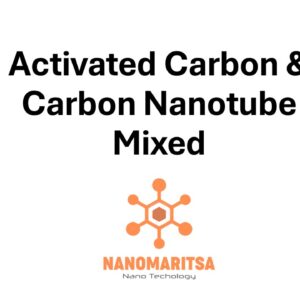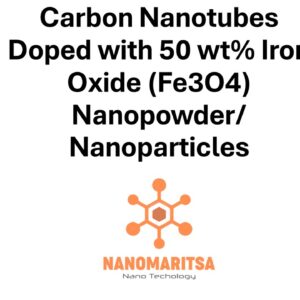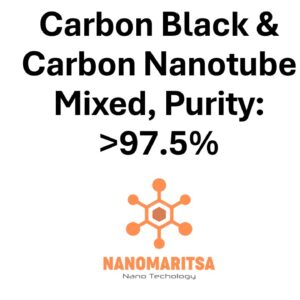Carbon Nanotubes Doped with 50 wt% Boron Nitride (BN) Nanopowder/Nanoparticles
€160.00
CompareCarbon Nanotubes Doped with 50 wt% Boron Nitride (BN) Nanopowder/Nanoparticles
Carbon Nanotubes Doped with 50 wt% Boron Nitride refers to a composite material in which carbon nanotubes (CNTs) are doped or mixed with boron nitride (BN), with boron nitride making up 50% by weight (wt%) of the material. This doping process alters the properties of the CNTs by introducing BN, which is a highly thermally stable, electrically insulating compound.
Properties and Benefits of CNTs Doped with 50 wt% Boron Nitride:
- Improved Thermal Conductivity:
- Boron nitride, especially in its hexagonal form, is known for its excellent thermal conductivity. Doping CNTs with BN could enhance the composite’s ability to conduct heat, making it suitable for applications requiring efficient heat management, such as in electronics or thermal management systems.
- Electrical Insulation:
- Boron nitride is an excellent electrical insulator, which contrasts with the high electrical conductivity of CNTs. The presence of BN could reduce the overall electrical conductivity of the composite, making it an ideal material for applications where electrical insulation is necessary while still maintaining the beneficial properties of CNTs, like mechanical strength and heat resistance.
- Increased Mechanical Strength:
- CNTs are already renowned for their exceptional mechanical strength. The introduction of BN could further improve the composite’s mechanical properties, especially in high-temperature or abrasive environments. BN may also help improve the material’s resistance to wear and friction.
- Enhanced Stability at High Temperatures:
- Boron nitride is highly stable at elevated temperatures, and its addition to CNTs could enhance the thermal stability of the composite. This would be beneficial for high-temperature applications, such as aerospace, electronics, or in materials exposed to extreme conditions.
- Lubricating Properties:
- BN, especially in the hexagonal form, has lubricating properties similar to graphite, which can reduce friction between moving parts. This could make CNT-BN composites useful in applications requiring lubrication, such as in advanced coatings, lubricants, or tribological systems (systems that involve friction).
- Improved Resistance to Radiation:
- Boron nitride has been shown to have resistance to radiation, making it suitable for use in radiation-sensitive environments, such as in aerospace, nuclear power plants, or electronic devices that need to operate in high-radiation conditions.
- Applications:
- Electronics and Energy Storage: The combination of high thermal conductivity, mechanical strength, and electrical insulation could make CNT-BN composites suitable for use in components like heat sinks, batteries, and capacitors.
- Aerospace and Automotive: The high-temperature stability and mechanical properties of the composite could make it useful in advanced aerospace and automotive materials.
- Coatings and Lubricants: The lubricating properties of BN make this composite ideal for use in coatings or materials that experience friction, such as in bearings, seals, or gears.
- High-Temperature Components: The thermal and mechanical properties could be beneficial in industries that require materials to perform under extreme conditions, such as power plants, electronics, or military applications.
- Radiation-Resistant Materials: Due to its resistance to radiation, this composite could be used in nuclear or space industries, where materials need to endure radiation without degrading.
Summary:
Carbon nanotubes doped with 50 wt% boron nitride create a composite material that combines the outstanding mechanical strength, conductivity, and flexibility of CNTs with the excellent thermal conductivity, high-temperature stability, and electrical insulation properties of boron nitride. This blend results in a material suitable for a wide range of high-performance applications, including electronics, energy storage, high-temperature environments, coatings, and radiation-resistant materials.
Technical Properties:
| 50 wt% BN Nanopowder/Nanoparticles | |
| Purity | 99.8% |
| Average Particle Size (nm) | 600 |
| Specific Surface Area (m2/g) | 1.0-6.0 |
| Color | white |
| Shape | irregular cubic |
| Carbon Nanotubes (Multi Walled Carbon Nanotubes) | |
| Purity | > 97 wt% |
| Color | black |
| Average Outside Diameter (nm) | > 50 |
| Average Inside Diameter (nm) | 5 |
| Length (µm) | 15-25 |
| Tap Density (g/cm3) | 0.15 |
| True Density (g/cm3) | ~2.4 |
| Specific Surface Area (m2/g) | > 65 |
| Ash | < 1.5 wt% |
| Electrical Conductivity (S/cm) | > 98 |
| Measurement (gr) | 25 grams, 100 grams |
|---|






